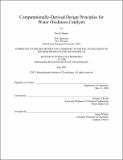Computationally-Derived Design Principles for Water Oxidation Catalysts
Author(s)
Harper, Daniel
DownloadThesis PDF (12.78Mb)
Advisor
Kulik, Heather J.
Terms of use
Metadata
Show full item recordAbstract
The water oxidation reaction can be used to produce renewable solar fuels, but efficient catalysts need to be discovered to enable its use at the industrial scale. The most active known water oxidation catalysts (WOCs) follow a common theme in chemical catalysis, relying on rare metals such as ruthenium and iridium. To discover alternatives that retain this level of activity while instead utilizing earth-abundant metals, tools need to be developed which leverage knowledge from computation and from existing systems to accelerate catalyst design. This thesis focuses on developing such tools for homogeneous transition metal complexes (TMCs), which are a promising for catalyst development because their properties can be finely tuned through precise ligand modification. To understand the underlying properties which drive water oxidation, we begin by studying the TMCs with the highest activity known thus far: ruthenium WOCs. By leveraging results from density functional theory (DFT), we identify a computational descriptor which correlates well with experimentally observed activity among these catalysts. This descriptor provides a link between computation and experiment, enabling in silico screening for novel WOCs, but it alone is not sufficient. Machine learning (ML) can be used in combination with DFT to further accelerate virtual screening and to extract chemical meaningful design criteria. To enable ML for our application, we next propose a new featurization method which more readily encodes known chemical trends. Our new featurization method, eRAC-185, demonstrates improved performance on data sets which simultaneously incorporate 4d metals, which are common in catalysis, and 3d metals, which are significantly more abundant. Together, our descriptor and featurization method provide the foundation for the computationally accelerated discovery of more active WOCs with earth-abundant metals.
Date issued
2021-06Department
Massachusetts Institute of Technology. Department of ChemistryPublisher
Massachusetts Institute of Technology